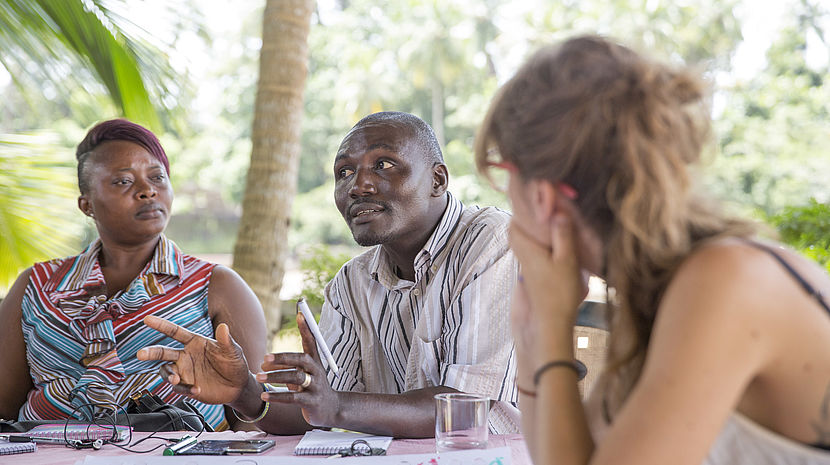18.10.2016 Persons with disabilities, the SDGs and UHC

In late September, working with CBM Germany, I had the wonderful opportunity to present at two VENRO workshops and meet with officials in Germany. The first presentation I gave was over “No Transformation without Inclusion: Social Equality, Empowerment and Participation of Persons with Disabilities” with a focus on persons with disabilities in development and the implementation of the Sustainable Development Goals (SDGs). The second was on “Leaving no-one behind through Universal Health Coverage and Health System Strengthening?” with a specific focus on persons with disabilities, the SDGs, and access to universal health coverage (UHC).
I have put my second presentation into written form below since it is a compelling, as well as timely topic, as one of the Goals in focus for HLPF 2017is Goal 3 on ensuring healthy lives.
Universal health coverage means that everyone has access to quality health services without experiencing financial hardship [1]. It is a fundamental human right for all people to have access to UHC and health systems and facilities have to be inclusive and accessible to all persons, including persons with disabilities who are more likely to lack health coverage since persons with disabilities are more likely to live in impoverished conditions and to be the most marginalized.
Persons with disabilities encounter specific barriers in accessing healthcare services. These include higher costs for persons with disabilities, lack of accessible transportation, and inadequately trained medical staff. Moreover, women and girls with disabilities face additional barriers, for example enhanced constraints on traveling independently or preconceptions about whether they need certain services, such as sexual and reproductive health services. [2]
The 2030 Agenda for Sustainable Development and its Sustainable Development Goals (SDGs) was adopted by the UN General Assembly in September 2015. This Agenda aims to build a better future for all people, including the chance to lead decent, dignified and rewarding lives and to achieve their full human potential and strives to end poverty, reduce inequalities, and save the planet from ecological degradation and climate change. The Agenda is universal, inclusive, and participatory in nature with an overarching focus on leaving no one behind. Universal health coverage should reflect the notion of leaving no one behind by providing access to people living in poverty first because they are often excluded and are the ones who face most difficulties in accessing basic services, including health care.
Research shows that ensuring access to quality health care for persons with disabilities increases their productivity and the wealth of their household. [3] Thus, good health should be seen as an investment rather than expenditure and UHC should be a top priority for sustainable development. And indeed, UHC is one of the cornerstones of sustainable development since healthier people are able to work more productively and have a higher educational performance. Accordingly, UHC is highlighted in the 2030 Agenda for Sustainable Development and its Sustainable Development Goals along with inclusive language that includes persons with disabilities.
Specifically, Goal 3 “Ensure healthy lives and promote well-being for all at all ages” is inclusive of all people, as well as target 3.8 “Achieve universal health coverage, including financial risk protection, access to quality essential health-care services and access to safe, effective, quality and affordable essential medicines and vaccines for all.” The current global SDG indicator 3.8.1 also includes all people, including persons with disabilities: “Coverage of essential health services (defined as the average coverage of essential services based on tracer interventions that include reproductive, maternal, newborn and child health, infectious diseases, non-communicable diseases and service capacity and access, among the general and the most disadvantaged population).”
Also, important is target 3.3 “By 2030, end the epidemics of AIDS, tuberculosis, malaria and neglected tropical diseases and combat hepatitis, water-borne diseases and other communicable diseases.” This is because if neglected tropical diseases (NTDs) are not addressed we will not achieve target 3.8 on UHC, Goal 1 on poverty eradication, Goal 2 on ending hunger, and Goal 4 on inclusive and quality education. Moreover, other goals, including Goal 6 on WASH, Goal 13 on Climate Change, and Goal 17 on MOI and the Global Partnership are closely linked in the elimination of NTDs.
Thank you to all my CBM Germany colleagues who supported my visit and stay, in particular Jan-Thilo Klimisch, Sarah Meschenmoser, Michael Herbst, Susan Pusunc, Veronika Hilber, and Maja-Lisa Mueller. It is a pleasure to work with all of you!
[1] WHO (2010). “The World Health Report 2010. Health Systems Financing: The path to universal coverage,” WHO Press, Geneva.
[2] CBM (2015). “Dialogues on Sustainable Development: A Disability-inclusive Perspective,” CBM.
[3] Danquah, L., et al. (2014). “The long term impact of cataract surgery on quality of life, activities and poverty: results from a six year longitudinal study in Bangladesh and the Philippines”. PLoS One. 2014 Apr 18;9(4):e94140.